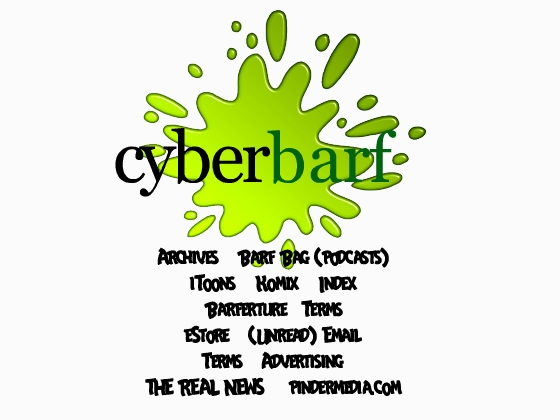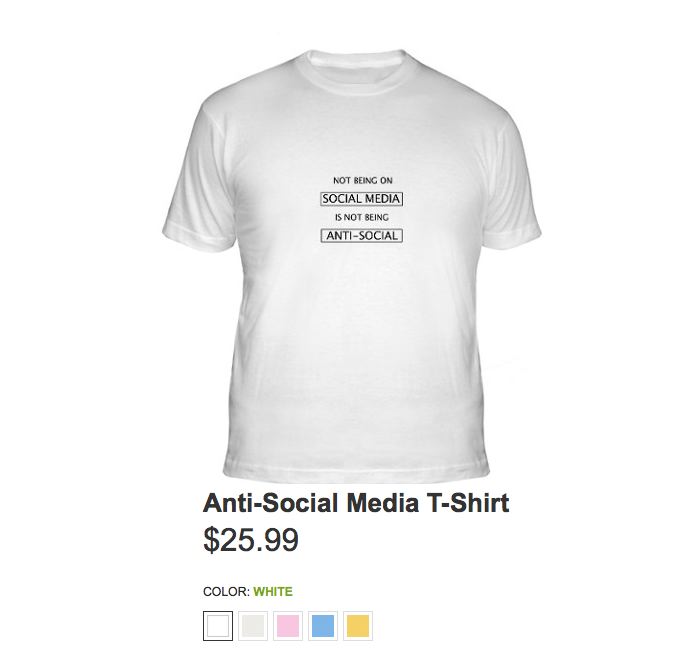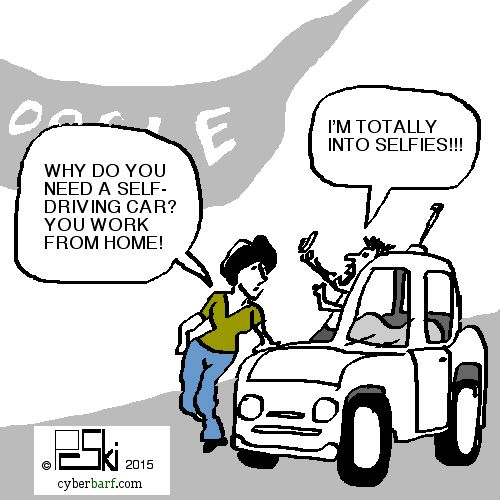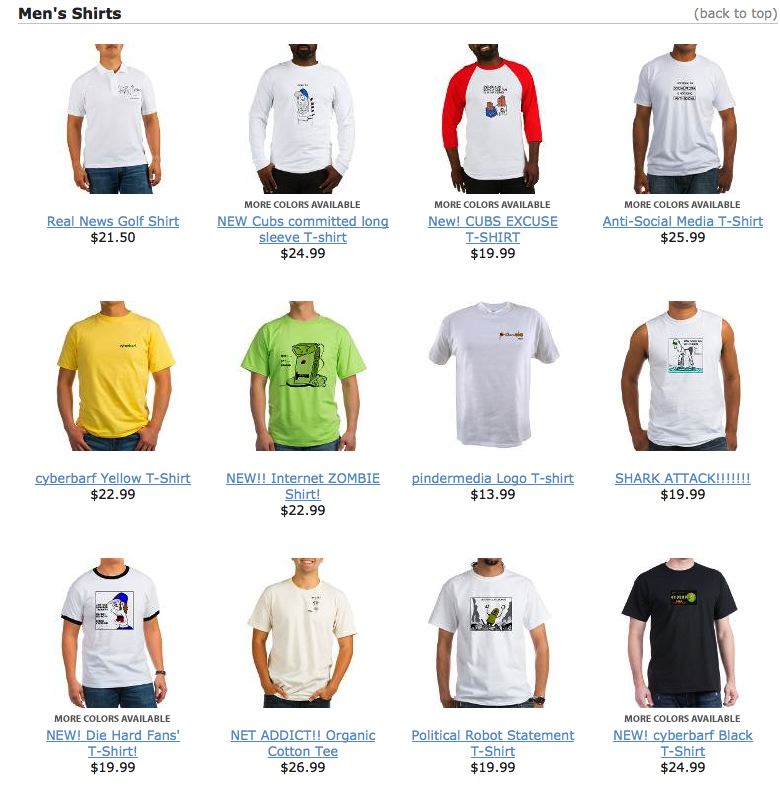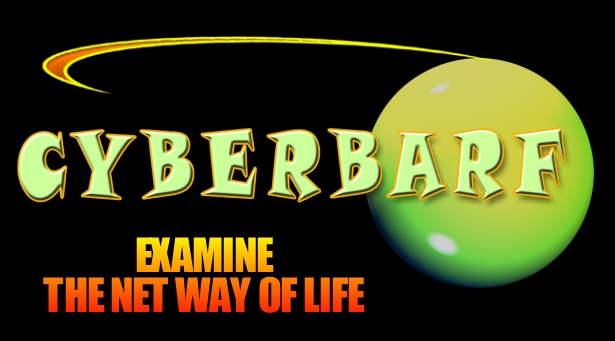|
LADIES' JAMS MULTIPLE STYLES-COLORS $31.99 PRICES TO SUBJECT TO CHANGE PLEASE REVIEW E-STORE SITE FOR CURRENT SALES "Hell hath no fury like a Liberal scorned!" - - - Dick Gregory
PRICES SUBJECT TO CHANGE; PLEASE CHECK STORE THANK YOU FOR YOUR SUPPORT! |
cyberbarf VOLUME 14 NO.10 EXAMINE THE NET WAY OF LIFE MAY, 2015 NOT LOST BUT FOUND BY OR FOR DESIGN iTOONS CANDIDATE RINGS WHETHER REPORT THE NERD BUBBLE
NEW REAL NEWS KOMIX! SHOW HACK!
©2015 Ski All Rights Reserved Worldwide Distributed by pindermedia.com, inc.
NOT LOST BUT FOUND ON THE INTERNET
Young boys used to play with Little Green Army Men as kids. The nostalgia of Toy Store brought these toys back into the mainstream. So it was strange to find a Japanese take on this iconic American toy. We wonder if this is more a commentary on how the rest of the World sees Americans. |
|
cyberbarf BY OR FOR DESIGN BARF It is one of those topics that crops up every so often: design. Specifically, the design of this site. Since by design, this has been a monthly digital zine on cyberculture it has been the old school format of a single “edition” home page. The grid has changed in columns or rows, but it has retained the basic format for the past decade plus. But the trend now is to Think Mobile. Thinking mobile means Tiles. We hate Tiles. Tiles are the bane of information because a partial headline and a graphic is not communication but a cheap link bait to a summary, at best. We don't like the concept of swiping our pictures, aggregation included, so the single finger pushers on the smartphones don't have to learn to read prose. Design just for design sake is a bad precedent. The focus should be on the content and not the alleged ease of distribution. The lesser viewpoint on the importance of content is that many high traffic sites are going “evergreen,” meaning that they are recycling old stories several months later as new content. With the mobile community's attention span growing shorter, the evergreen strategy might fool an audience. It is not that we are against improving the site's look and feel. We have over the years introduced new features and concepts, and dropped a few along the way. Change can be good. Change can great. Change can lead to new exploration of ideas. But there has to be some logical strategy behind change. Otherwise, you are merely sheep following the line off a cliff like lemmings into the sea. (A woolly lemming would probably make an excellent trending meme.) The one problem with having a monthly publication with the first of each month the deadline date to upload is that one can be pressed for time to get all the new elements in order (copy, editing, cartoons, and comics.) One solution could be to spread out the content creation and publication into smaller bites, like weekly uploads. But in some ways that just adds four deadlines instead of one big one. Another alternative would be run the site more like a blog, where posts are randomly published on the whim of the writer. That is well and good, and works in some situations, but that too can be a drag in both daily contemplation “to do something” to shorten content and analysis because one stumbles over something that posts quickly with a few throw away lines. That is why celebrities get in trouble shooting from the hip without gatekeeping function on Twitter. The monthly publication cycle has one advantage. It has lead to an incredibly stable base number of unique monthly visitors. If readers are trained to find a new monthly publication, they will visit once or twice every 30 days to review and read the current home page (or search the archives for past content.) This stability is hard to come by for small sites floating in the ocean of the internet information overload. And there is a stubborn professional nostalgia at work here. We have doing this for so long in digital world terms in the same way it almost becomes a vintage homage to the past early net days. Since this site was directly related to porting desktop publishing to the web, the page concept is still a strong part of its DNA. If this site was a full time gig with the need to drive traffic and update content hourly in order to generate the nebulous advertising dollars, then the move to Tiles and mobile quips would be the business model. We learned very early on that 99.9 percent of web operators don't make any real money. When users still say the Internet is free, they mean it. We may try to experiment with tweaking the current monthly static home page. Next to the lead index, we may use the left column to publish new items (commentary, articles, essays, etc.) as time allows during the month. Whether these will be links to a secondary page or flip the reader to the bottom of the page, we do not know yet. There is a question of archiving a monthly publication that may be amended from time to time. One suggestion is to use these new posts as the basis for next month's issue, but that seems to defeat the purpose of independent updates. That suggestion goes to the idea that more updates means more work when time is a premium resource. So changes are afoot at cyberbarf, for good or ill. How it plays out is like how things are playing out on a global basis. Old media is wrestling the idea of preserving their legacy platforms while newer technology and younger users are more focused on the easy candy content providing platforms such as swipe and go smartphone apps. So this site may go through a few new monthly feature updates. There are many key public debates that will fire up this year as the wild, wild west of the free Internet is trying to be contained by the FCC's marshal law. New gadgets like Apple's Watch may be expensive luxury items or transformative medical devices once it is released in the wild.
|
cyberbarf.com EXAMINE THE NET WAY OF LIFE
iToons
|
|
cyberbarf CANDIDATE RINGS POLITICS Pew Research Center’s Project for Excellence in Journalism studied the Internet use in the past campaigns use of the websites, their postings on Facebook, Twitter and YouTube-and the public reaction to that content showed many inventive uses to connect to voters. In theory, digital technology allows leaders to engage in a new level of “conversation” with voters, transforming campaigning into something more dynamic, more of a dialogue, than it was in the 20 century. For the most part, however, the presidential candidates are using their direct messaging mainly as a way to push their messages out. Citizen content was only minimally present on Milt Romney’s digital channels. The Barack Obama campaign made more substantial use of citizen voices-but only in one area: the news blog on its website where that content could be completely controlled by the campaign. Managing the media is one of the real keys in any election. The message and its distribution is more important to a candidate than either truth or accuracy on the issues. The Internet has proven that people will seek out validation of their own opinions over trying to find out information in which to form opinions. The way to trigger bias responses in potential voters is the key to having them support a candidate. The Pew study of the direct messaging of the candidates also revealed something about the arguments the two sides are using to win voters. Romney’s campaign was twice as likely to talk about Obama (about a third of his content) as the president was to talk about his challenger (14% of his content). This is a holdover from old school campaign speech writers who believe that an incumbent should not mention their challenger because that infers that he or she is the incumbent's equal. On the other hand, a challenger must attack their opponent and their record in order to make a case for change. That began to change some in late July, 2012 when the Obama campaign revamped its website. And while the troubled economy was the No. 1 issue in both candidates' digital messaging, the two camps talk about that issue in distinctly different ways. Romney's discussion focuses on jobs. Obama's discussion of the economy is partly philosophical, a discourse on the importance of the middle class and competing visions for the future. Campaign managers dread their candidates making promises that they cannot keep. They also dread a detailed plan for their vision since an opponent can quickly counterattack the details as being impossible, not credible or a fantasy. The Pew study found that Obama's campaign has made far more use of direct digital messaging than Romney's. Across platforms, the Obama campaign published 614 posts during the two weeks examined compared with 168 for Romney. The gap was the greatest on Twitter, where the Romney campaign averaged just one tweet per day versus 29 for the Obama campaign. Obama also produced about twice as many blog posts on his website as did Romney and more than twice as many YouTube videos. One of the tenets of Internet hosting is that new content drives traffic. The net is a beast that needs to feed search engines, trend lines and RSS feeds with politics no exception to that rule. The 2012 campaign was about the economy, but what that means differs depending on to whom one is listening. Typically, an incumbent President is running on a referendum of his handling of the economy. President Bush once campaigned on the slogan whether the voter were better off today than when the incumbent was elected to office. Roughly a quarter, 24%, of the content from the Romney campaign was about the economy versus 19% of Obama campaign posts. But Romney devoted nearly twice the attention as Obama to jobs. Obama’s attention to the economy was almost equally divided between jobs and broader economic policy issues such as the need to invest in the middle class and how the election presents a choice between two economic visions. In that respect, Obama was not positioning himself as a barometer of voter attitude toward the economy but as just another candidate trying to help them by tweaking policy. The Pew study also showed that the number of topics of the digital conversation changed in just four years. Gone from four years ago are web pages focused on veterans, agriculture, ethics, Iraq and technology. New are pages were about tax policy - - - and the two campaigns overlap on fewer issues than Obama and McCain did. The economy may have dominated both candidates' digital messaging, but it was not what voters showed the most interest in. On average Obama's messages about the economy generated 361 shares or retweets per post. His posts about immigration, by comparison, generated more than four times that reaction; and his posts about women's and veterans' issues generated more than three times. This was also true of attention to Romney's messaging. His posts on health care and veterans averaged almost twice the response per post of his economic messages. Every campaign tries to get the base party voter on board early. In order to do that, candidates tend to speak in buzzwords or soundbites that resonate with their target audience. For liberal Democrats, the issue of immigration reform was more buzzworthy to them than speeches on jobs or economic reform. Despite the opportunity to use their followers as messengers, neither campaign made much use of the social aspect of social media. The campaigns rarely replied to, commented on, or retweeted something from a citizen-or anyone else outside the campaign. On Twitter, 3% of the 404 Obama campaign tweets studied during the June, 2012 period were retweets of citizen posts. Romney’s campaign produced just a single retweet during these two weeks-repeating something from his son Josh. Campaign websites remain the central ring for all its digital political messages. The main candidate home page is the repository of links to all the key aspects of the campaign: information, messages, data mining and financial support. Even if someone starts on a campaign's social network page, they often end up back on the main website-to donate money, to join a community, to volunteer or to read anything of length. The final Obama page emphasized the centrality of the campaign website such as embedding the YouTube channel campaign videos directly into the website guaranteeing which videos the ones Obama wants voters to see. With two national presidential races in the books, there is a wealth of information on how effective digital platforms are for candidates. But since social media and distribution has changed since 2012, the cautionary tale is that current campaigns need to keep up with the technology times. There have been several myths broken on website usage in politics. First, the donate button on a home page is nice, but it will not drive significant campaign dollars. This is more dramatic for state and local candidates. Campaign management firms still believe that the best way to raise funds is old fashion politics: making calls and holding events. Second, a flashy website will not run the campaign for the candidate. Candidates who simply put up websites and then sit back and expect to win, or who do only minimal campaigning and rely on their website to do the rest, will be shocked come Election Day. There is no substitute for old fashioned campaigning, not even the Internet Voters still want to be wooed by candidates on a personal level. That is why the rise of the robo-phone call which seeks to leave candidate voice mail messages is a more effective way to interact with a potential voter since the candidate is communicating directly with the person in their own home. This is the digital equivalent of shaking hands and a hello with a commuter at the train station. People respond to a candidate making an effort to reach out directly to them. But there are still valid reasons to put resources into web. A campaign web site can get information out quickly and cheaply with press releases, issue papers, articles, and even campaign posters out to the public in a short amount of time. And with the news media cutting back on staff and editors, overworked reporters will look to candidate web pages for sources of background information for their articles. There is a great advantage of having web information crafted by the candidates speech writers be lifted into national media stories. And since one can craft the website as the hub for people to come to resources, you can use other social media (Facebook, Twitter, Instagram, YouTube, etc.) to funnel people back to the home page libraries for more information. A field operative could use Twitter to keep the media and public aware of a candidate's schedule, while at the same time direct links back to the main website. A public relations firm can post a candidat''s ads in various media platforms. The more secondary sources for interested people to look to, the less likely is it to change the candidate's stump speech. Most candidate gaffs, mistakes and crippling snafus come when a candidate goes off his or her prepared speech to react to a question, heckler or react to an event. It is so easy for a candidate to dodge tricky situations by simply referring the inquiry back to their web site. Social media will be used more in campaigns as the means to keep connected with their supporters. The various social media platforms allow a campaign o stay connected with its supporters - - - as a substitute to phone calls and mass mailings which take time and money. By using an e-mail list to stay in touch with supporters, a campaign can quickly respond to attacks, mobilize them for an event, remind them to go to the polls, and keep your political campaign in their minds, all for a fraction of the cost of direct mail or phone banks. Political campaigns exist to do one thing: win on election day. To win, campaigns need to get 50 percent plus one of the vote, To win in 2016, the presidential campaigns will need to fulfill three basic functions: First, they need to recruit and hold volunteers, donors and potential voters. Digital media resources can be used to keep in constant contact with these three groups - - - to keep them in the inner corridors of the campaign - - - since an engaged worker or donor is more apt to do more. Second, they need to get their workers and staff to put needs into action, whether it is to get money, man phone banks, canvass or poll potential voters or simply turn out to remind supporters to vote. Third, they need to get out the campaign’s political themes out to the right audiences, whether a broad audience (all voters in a district) or a narrow one (journalists, bloggers, Latinos over 40, women under 30, union members, Tea Partiers, etc.). Everything a campaign does - - - everything - - - has a cost, even if that cost is a few minutes of a staff member or volunteer's time. Successful campaigns will be ruthless when it comes to resources like time and money - - - i.e., they will not waste them unless it is unavoidable. Technology services (IT) can be very expensive to maintain and update content so unless it is tailored to contribute in a significant way with recruiting, mobilization or messaging - - - it may be a misuse of limited resources. Efficiency and effectiveness of messaging is the key to campaign victories. One can have the greatest web and digital media flash and glitter but if it is inefficient, costly or ineffective in cementing a clear message to voters, the candidate will likely lose. But a candidate's website look does matter, since a well designed layout can help make a good first impression which draws people, like in any retail situation, to browse more. Then, once inside the website, most voters, bloggers and journalists will ultimately come back to a candidate's site for substance. When it comes to the process of converting visitors into activists, content is key, such as telling the candidate's story through words, photos and video. Integrating the site with other aspects of the campaign's online outreach is important, since the site will be stronger when it’s used to aggregate, organize and feature content from YouTube, Twitter, Flickr, blogs and the various other facets of a campaign's online presence. It can become a one-stop shop for visitors through the prism of how the campaign wants to present its candidate (as opposed to independent media or their opponent.) Campaign advisement firms like to think now with the concept of Constituent Relations Management Systems which are programs and policies which reach out to their target audience through email blasts, Facebook, Twitter and text messaging as a means to influence the wider public discussion and to recruit new supporters and donors. Outreach can include a wide array of possible channels including online advertising, digital video, Facebook, direct pitching to bloggers and other activists behind the scenes, Twitter and more. Most technologies a campaign employs will fit into one of those three areas. Web page design and apps are the tools which a savvy campaign can attempt to exploit in order to attract people. To think about it another way,web tools and platforms are important, but only fools ignore the vast difference between having the technology and using it effectively. Successful campaigns spend as much time planning their activities and developing procedures as circumstances allow - - - so they know that while anyone can send a mass email, getting the most out of an email list takes an actual strategy. As simple or sophisticated as a given tool is, what really matters is how you use it. That is why the new technology cannot eliminate the need for a well seasoned, experienced campaign staff directing the content. In the next few months, there will be many presidential candidates rolling out digital content resources to launch their campaigns. Hillary Clinton announced her candidacy by social media, which got lukewarm response from the political community. A dud launch or a lame campaign website can actually do more harm than good. There needs checks and balances in place to keep the candidate and staff on message, because no one wants to give an opponent a Dukakis-in-a-tank counter photo opportunity to derail a candidate. |
|
cyberbarf THE WHETHER REPORT |
cyberbarf STATUS |
| Question: Whether the end of the Comcast-Time Warner cable merger talks signals weakness in the old cable business model? |
* Educated Guess * Possible * Probable * Beyond a Reasonable Doubt * Doubtful * Vapor Dream |
| Question: Whether one million initial orders for Apple's Watch going to be seen as a successful product? |
* Educated Guess * Possible * Probable * Beyond a Reasonable Doubt * Doubtful * Vapor Dream |
| Question: Whether Internet gambling will increase prior to the 2016 presidential election? |
* Educated Guess * Possible * Probable * Beyond a Reasonable Doubt * Doubtful * Vapor Dream |
|
cyberbarf EXAMINE THE NET WAY OF LIFE cyberbarf THE NERD BUBBLE CYBERCULTURE In 2011, TIME Magazine thought that the Nerd culture bubble had burst with the overcommercialization of San Diego Comic Con. It had a valid premise but not in a macro-view. The SDCC began as a small comic centric private trade show between fans and some publishers. It steadily grew into an event when the scope of the show expanded into television (specifically sci-fi), anime and film crossovers back to the comic world. But it got its crazy party vibe with the explosion of cosplay. Cosplay is basically Halloween costumes worn on any day except October 31st. People spent a lot of time and resources to recreate the wardrobe, weapons, blades and make-up of their favorite fictional characters. Halloween is now a top money spending holiday in the United States because it is no longer just for children to trick or treat. Adult parties have spawned more venues to show off your cosplay skills - - - and a new circuit of regional comic and fantasy conventions was born. After years of rapid growth in convention space, attendance and celebrity panels, SDCC got too big for its original mission. Major Hollywood studios pushed their way through the hall doors to promote their latest tent pole summer movies. More top line celebrities made the trip to San Diego to be fawned over in packed panel rooms. The program got too popular - - - almost to the scale of a parody of itself. Instead of celebrating a subculture of entertainment, it became its own cultural icon. Some older fans lament that SDCC got greedy; the influx of studio money made everything more expensive, more crowded and less appealing to attend. Money corrupts principle. The main sponsors opened their doors to the influence and grandeur of a Hollywood spectacle even if it would upset long term attendees. As with any new (and profitable) cultural scene, the Nerd space has many meanings to different people. Wikipedia defines Nerd (adjective: nerdy)as a descriptive term, often used pejoratively, indicating that a person is overly intellectual, obsessive, or socially impaired. They may spend inordinate amounts of time on unpopular, obscure, or non-mainstream activities, which are generally either highly technical or relating to topics of fiction or fantasy, to the exclusion of more mainstream activities. Additionally, many nerds are described as being shy, quirky, and unattractive, and may have difficulty participating in, or even following, sports. Though originally derogatory, Nerd is a stereotypical term, but as with other pejorative, it has been reclaimed and redefined by some as a term of pride and group identity. Steve Wozniak is an example of a technology nerd. He single-handedly designed of the most iconic early Apple computers. Some interests and activities that are likely to be described as nerdy include: Intellectual, academic, or technical hobbies, activities, and pursuits, especially topics related to science, mathematics, engineering, linguistics, economics, literature, sociology, geography, mythology, history, and technology. Hobbies, games, and activities that are described as obsessive and immature, such as trading cards, comic books, fantasy and science fiction novels, television programs and films, role-playing games, tabletop games, and video games and anime. Interest in the fine arts, non-mainstream music such as classical, progressive rock, techno, or folk music, hobbies (i.e., collecting), or other "obscure" interests. Heavy obsession with a topic that would otherwise be mainstream (such as a popular TV show or a sport). The stereotype was best launched to the present elevated status with the film, Revenge of the Nerds. In the film, a group of awkward, shy, socially challenged, but highly intellectual freshman become bullied and threatened by the college popular group (jocks and cheerleaders) until the nerds turn the redemptive tables on them. Many people still find individuals who have the above interests social outcasts or undesirable, even though studies have shown that nerds land more technical and high paying jobs and professions, have more stable home lives and lead more interesting lives because of the diversity of their interests. The demographic grew when it hit the critical mass of national media acceptance. Cult TV classics that relied on science fiction intellectually deep mythology such as Star Trek or Star Wars turned into mainstream crossover success stories. The organic growth of nerd culture were tech shows, video game reviews to competitive tournaments, comics being made into summer blockbuster movies, to the general acceptance that smart people can have fun interests. Today, the highly rated network comedy, The Big Bang Theory, both satirizes and celebrities this culture. The Internet has also spurred the growth of nerdisms. Many nerds were quickly drawn to the new medium of podcasting to supplement and grow an audience. Early podcasters then expanded into video channels on platforms like Machina or YouTube. Younger performers began their apprenticeships in entertainment with the new technology at their fingertips such as Twitter and Vine. Advertisers caught wind that these young, nerdy, tech comedians and performers could capture hundreds of thousands of unique views which could lead to real, verifiable ratings for sites to make money. It is still rare that a YouTube star can make a great living just on weekly video podcast show. A business magazine speculated that even an Internet star with a million views could generate hundreds of thousands of dollars of revenue, but after platform splits, taxes and production costs, the star may only bank twenty thousand dollars - - - the equivalent entry level pay of a recent college graduate. But if one is going what they like on their own terms, and even college grads have a hard time finding jobs in their fields, Internet nerds may believe they are better off. Besides, the goal for many is to move their audience to a bigger media platform: cable or network television. When the mainstream media gets a hold of a fad it usually signals its demise. Maybe this time, the young web performers who have a loyal niche audience before making the jump will fair better than their 1990s comedy club predecessors. Who does like Grace Helbig? She is a comic actress who build up a large following (of tween girls and young women) on her It's Grace YouTube programs. She is attractive. She has a sly, dry wit. Viewers like that she has the girl next door personality. As a result of her web popularity, Grace was given a half hour show on the E! Network. A normal four minute video diary or skit with friends on YouTube does not necessarily transfer well to a hour hour comedy format. The Grace Helbig Show pilot was choppy but that is expected when one is trying to transfer what works on the net into the format of commercial television. Yes, there are game bits and some light talk show segments. But the flow of the show (stretching old web timing to a new platform) still needs work. The other unknown is whether her web audience will actually follow her to cable TV. Many young viewers cut the cord and live on their mobile devices or computer screens. The trend of nerd culture reminds us of another previous subculture group that rose quickly in the mainstream consciousness but then faded back to its own world: steampunk. Steampunk is a subgenre of science fiction and sometimes fantasy—also in recent years a fashion and lifestyle movement—that incorporates technology and aesthetic designs inspired by 19th-century industrial steam-powered machinery. Although its literary origins are sometimes associated with the cyberpunk genre, steampunk works are often set in an alternative history of the 19th century's British Victorian era or American Wild West freedoms but in a post-apocalyptic future during which steam power has maintained mainstream usage, or in a fantasy world that similarly employs steam power. Steampunk is now most recognized by the Maker movement where craftsmen and artists repurpose old items into modern appliances. For example, a maker might take a modern computer keyboard and replace the keys with that of an old manual typewriter. This creates an H.G. Wells or Jules Verne retro-cool look. Along with functional art pieces, Steampunk also refers to vintage clothing fashions blending Victorian-era fiction, art nouveau design, and early 19th Century industrial brass fittings. So it is fitting to compare the Nerd popularity to past trends like the Steampunk movement. It is only a matter of time until something new and different becomes the Next Cool Thing to put Nerd culture back towards its smaller community roots.
|
|
THE PINDERMEDIA STORE IS FULL OF FUN T-SHIRTS CLOTHES, HATS AND OTHER ITEMS. CHECK OUT THE STORE FOR ITEMS
SUPPORT cyberbarf VISIT THE CYBERBARF STORE! Prices and styles may vary depending on sales, allotments, inventory. |
|
BACK IN BLACK WITH THIS CLASSIC CYBERBARF T-SHIRT!
FEATURING: THE REAL NEWS IMPACT EDITORIAL CARTOONS WRIGLEYVILLE WAR POLITICS ENDORPHIN RUSH THE DARK ABYSS RANDOM ELECTRONS SPECIALS
FEATURING: THE REAL NEWS ARCHIVES CARTOONS MADAME'S TEA HOUSE THE BAR EXPLORE THE CITY SCAPE UNDER CONSTRUCTION SURPRISES ESTORE SPECIALS |
NEW THEORIES AND CHARACTER ESSAYS INCLUDING 10 YEAR ANNIVERSARY ARTICLES
cyberbarf
THE STEAM PUNK SPECIAL EDITION featured new Music from Chicago Ski & the (audio) Real News: (mp3/4:14 length)
EXAMINING THE NET WAY OF LIFE cyberbarf™ distributed by pindermedia.com, inc.
|
cyberbarf
Distribution ©2001-2015 pindermedia.com, inc.
All Ski graphics, designs, cartoons and images copyrighted.
All Rights Reserved Worldwide.
